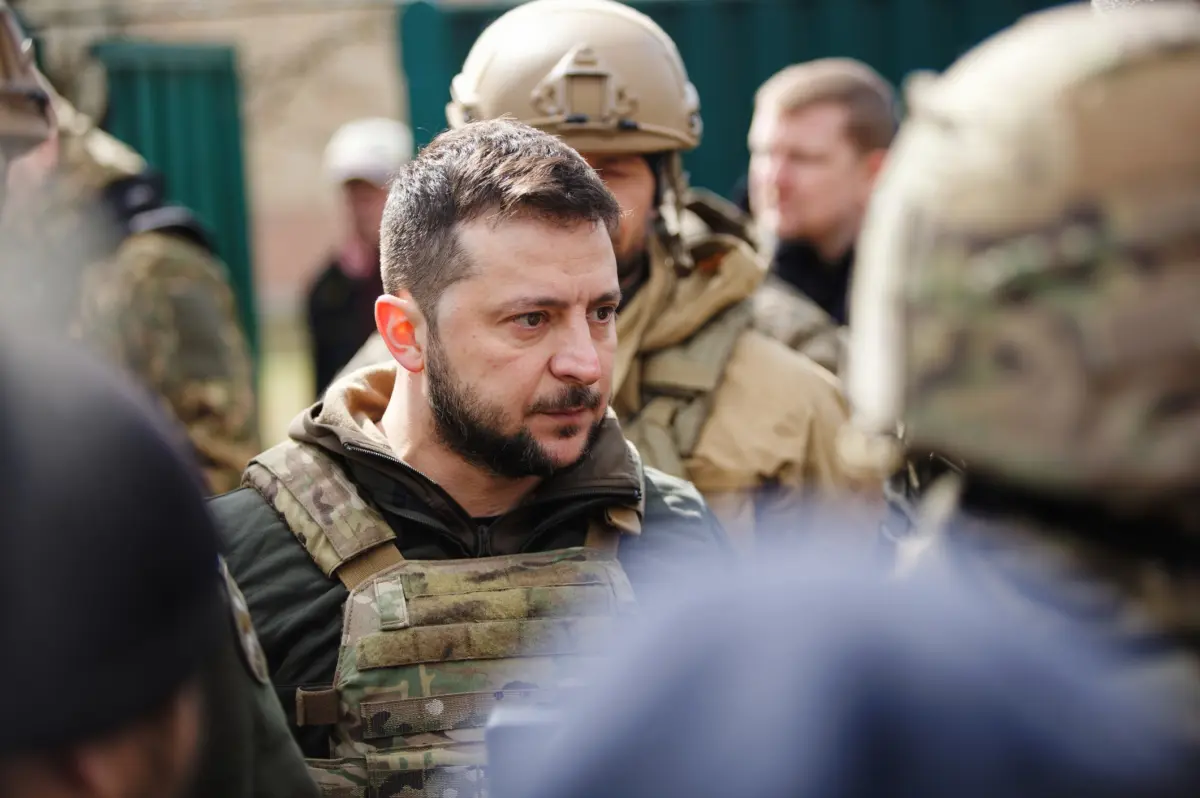Among the many oddities of the new US approach to the Russian-Ukrainian war is the assumption that early elections in Ukraine could be helpful or even decisive in ending the fighting.
In particular, the claim that peace can be achieved with a quick replacement of the Ukrainian leadership—especially President Volodymyr Zelensky—is now being advocated not only in Moscow, but also in Washington. These actors present such a scenario as plausible despite the fact that political change in Ukraine is unlikely in the near future given both the country’s politics and realities on the ground.
It is unrealistic to expect meaningful presidential and parliamentary elections to be held in Ukraine during wartime or even shortly after any cease-fire. Not only does Ukrainian legislation, just like that of many other countries, ban elections during periods of martial law. The full-scale Russian invasion that has been ongoing since 2022 makes nationwide voting logistically and security-wise impossible.
Moreover, elections will require a longer period of preparation after fighting has ended. The war has had such a devastating impact on Ukrainian society and infrastructure that there is now a consensus in the country that a new law for postwar elections must be passed and implemented to take account of the new circumstances. Preparing elections after the war would take at least half a year and could take up to a year. None of this is unusual in a post-conflict scenario.
Orderly elections are impossible
The latest calls for political renewal in Ukraine are therefore premature and naive at best—and manipulative and subversive at worst. Russia’s hold over large parts of eastern and southern Ukraine, the continued fighting, and ongoing Russian airstrikes across the entire country have made it impossible to hold orderly elections.
A public appeal by Ukrainian civil society groups—organised by Opora, the country’s leading election-monitoring group—stated on February 20: “The unstable security situation; the risk of shelling, terrorist attacks, and sabotage; as well as the large-scale mining of areas, pose significant obstacles at all stages of the electoral process.”
Moscow’s official rationale for its demand for Ukrainian elections is an alleged concern for the legitimacy of the Ukrainian leadership. That is a strange claim, considering that Ukraine’s elections are widely recognised by international observers as free while Russia’s are not. Russia’s goal is not to protect popular rule in Ukraine, but rather to use the country’s increased vulnerability during a national election campaign and voting procedure for state subversion.
The motive behind the Russian campaign for early national elections in Ukraine is not a stable peace between the two countries, but the domestic destabilisation and subsequent vassalisation of Ukraine.
Moscow’s hidden motives
Some commentators may be unaware of, or dismiss as unimportant, the hidden motives behind Moscow’s supposed interest in Ukrainian democracy.
However, the subversiveness of Moscow’s demand for elections should not be underestimated. One indication that state disruption—not an orderly transition of power—is the goal behind Russia’s professed concern for democratic legitimacy in Ukraine is that, as Moscow knows, even successfully conducted elections would likely do little to change Ukraine’s foreign policy.
A hypothetical change of leadership in Ukraine in the near future, including a new president, will not lead to substantial Russian-Ukrainian rapprochement, contrary to the opinion of some external observers.
Most polling data, as well as the larger political landscape since the start of Russia’s full-scale invasion in 2022, suggest another presidential election victory for Zelensky.
To be sure, it is unlikely that he will repeat his landslide of 2019, when he won nearly 75 per cent of the vote in the second round of the presidential election. Zelensky’s poll numbers have fluctuated over the past three years, and the outcome of any election is therefore difficult to predict. In 2024, the popularity of General Valery Zaluzhny, the former commander in chief of the Ukrainian Armed Forces who is now the Ukrainian ambassador to the United Kingdom, overtook that of Zelensky in several polls.
Zaluzhny—whom Zelensky promoted to command the military in 2021—would be a potent political competitor in a presidential election. So far, however, Zaluzhny has neither indicated presidential ambitions nor engaged in any party-building or other preparations for entering politics and running a campaign. After his posting to London in 2024, he has become less present in Ukrainian public life, although popular support for him is still higher than for any other hypothetical rival to Zelensky.
Zelensky continues to poll far ahead of all active Ukrainian politicians in various political parties. His closest rival with official political ambitions is former President Petro Poroshenko, who suffered a spectacular defeat to Zelensky in 2019. Poroshenko currently receives less than half of Zelensky’s support in opinion polls. As long as Zaluzhny does not enter party and electoral politics, Zelensky remains the absolute favourite in the next presidential election.
An Zelensky defeat would change nothing
Even if a serious rival were to emerge and win, it would not change the basic outline of the war. The main political opposition to and criticism of Zelensky and his Servant of the People party comes from the nationalist centre-right and nationally oriented civil society.
There remain only a few notable actors in Ukraine who might push for a rapprochement with Russia, and they have a residual audience. Since 2022, they have either lost much of their appeal with voters—as in the case of Yuriy Boyko and Dmytro Razumkov—or left or were deported from the country, as the openly pro-Kremlin Viktor Medvedchuk and the former media magnate Yevhen Murayev did.
Today, none of them can be considered a serious contender for the Ukrainian presidency.
Zelensky, notwithstanding his Jewish family background, is frequently labeled a ‘Nazi’ by Moscow. Among those in the West pushing for an accommodation with Russia, many see him as a ‘hawk’. Most Ukrainians, however, have perceived him as a relatively moderate, dovish politician since the start of his political career.
Since coming to power in 2019, Zelensky and his team have often been criticised in Ukraine for being overly optimistic, soft, and indecisive on Russia. Zaluzhny’s high popularity in polls is partly based on the hope that the general would be more decisive and effective against Russia.
Kyiv’s stance could harden, not soften
Ukrainian political observers widely expect veterans to play an important role in the country’s postwar politics. Current and former military personnel with front-line or command experience are now seen by many Ukrainians not only as well suited to protect their country from the Russian threat, but also as less corrupt, more patriotic, and better qualified for leadership positions than traditional politicians.
None of this portends the election of a leadership eager to accommodate Russia, let alone bend to its will.
In future elections, men and women with military backgrounds will likely increase their presence in the government, national parliament, regional administrations, and local councils; they might run on the tickets of existing parties, as independent candidates, or as part of new political groups with a military profile.
We’re very likely to see a massive entry of former soldiers into Ukrainian politics, which will harden rather than soften Kyiv’s stance toward Moscow.
Misjudgment in Washington
Recent unofficial US contacts with Poroshenko and former Prime Minister Yulia Tymoshenko, clearly meant as outreach to possible successors to Zelensky, indicate a threefold misjudgment in Washington.
First, most observers familiar with Ukrainian politics would dismiss a future Tymoshenko or Poroshenko presidency as unrealistic. Although they are still present in public life and hold seats in parliament, to Ukrainians, they represent a bygone era and symbolise the problematic past of early post-Soviet Ukraine.
Their parties—Poroshenko’s European Solidarity and Tymoshenko’s Fatherland—will probably continue to have seats in the next parliament, but the two veteran politicians have little chance of gaining power again.
Second, both Poroshenko and Tymoshenko have made it clear to their U.S. counterparts that they are opposed to early elections. Instead, they share the widespread Ukrainian rejection of conducting campaigns and elections during wartime. The two politicians would likely be just as skeptical about holding elections too soon after the lifting of martial law, without a longer period of preparation for a proper and secure electoral process.
Third, the political consequences of a hypothetical presidency of Tymoshenko, Poroshenko, or any other conceivable presidential candidate are overestimated in Washington. The change would do little to change Ukraine’s foreign-policy orientation in general and its attitude toward Russia in particular. If anything, Tymoshenko’s and Poroshenko’s parties are more nationalist than Zelensky’s. Both politicians have distinguished themselves in the past by making bellicose statements against Russia and Russian President Vladimir Putin.
Myths made in Moscow
There is an obvious discrepancy between calls for elections in Ukraine and their negligible or more likely negative impact on Kyiv’s willingness to make concessions.
This contradiction is linked to the fact that the call for elections in Ukraine, allegedly intended to help end the Russia-Ukraine war, originated in the Kremlin and serves destructive purposes. Neither the wartime suspension of Ukrainian presidential and parliamentary elections—as required by the country’s pre-war legislation—nor Zelensky himself are responsible for the lack of progress in negotiations between the United States, Ukraine, and Russia.
The double myth that the current Ukrainian government is illegitimate and that fast elections are necessary to end the fighting was created in Moscow.
Having to improvise elections in a war-torn country would allow the Kremlin to unleash its full political warfare machine, including disinformation, cyberattacks, intimidation, sabotage, and corruption. Adopting Russia’s call for elections would be a serious mistake for other international actors involved.
Photo: Dreamstime.







